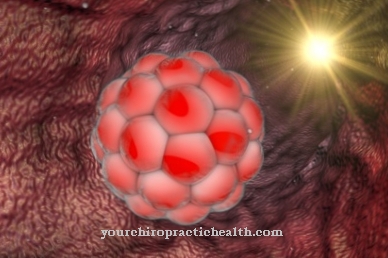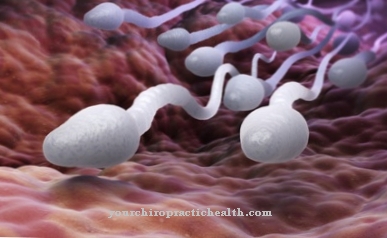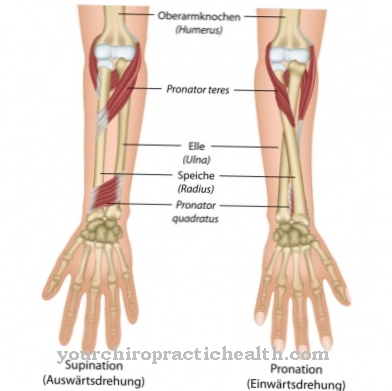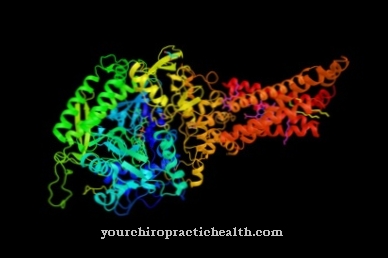In the Erythrocyte aggregation red blood cells collect and clump together. The phenomenon is physiological to a certain extent, especially in the smaller capillaries. In the context of immune complex diseases, for example, this physiological level is exceeded.
What is erythrocyte aggregation?

The red blood cells are also called erythrocytes. Erythrocytes are cells without organelles that can no longer divide. The cells have a biconcave flattened shape, the main component of which is red hemoglobin. The shape of the cells increases their surface area and thus creates better conditions for gas exchange.
Erythrocytes are highly flexible and come in several dozen different shapes, such as anulocyte or macrocyte. They can adapt their shape and in this way migrate through capillaries with a smaller diameter than they own.
Under the cell membrane of the cells lies a filament network that radiates into the membrane. The network of filaments gives the red blood cells their dense structure and creates a so-called erythrocytic cytoskeleton. Proteins such as spectrin and ankyrin are essential for their structural shape.
There is an attraction between red blood cells. This force becomes effective at low blood flow velocities. Erythrocytes accumulate in so-called pseudoagglutination to form rouleaux in order to be able to pass vessels better. The rouleaux thus corresponds to a roll-up of red blood cells, which is made possible by plasma proteins. The dissolving of a roller blind is possible with the help of slight mechanical forces.
Erythrocyte pseudoagglutination is a form of erythrocyte aggregation or erythrocyte agglomeration. Each type of aggregation corresponds to an agglomeration of biological physiological elements.
Function & task
Erythrocyte aggregation takes place on the basis of the forces of attraction that exist between individual erythrocytes. Since these attractive forces are relatively small forces, aggregation does not occur at regular flow velocities. The pseudo-aggregation or roll formation mainly occurs when the blood flows slowly or stands still.
In this situation, the red blood cells clump together to form a rouleaux. This pseudoagglutination is reversible. Weak forces are enough to dissolve the "roll of money" made up of red blood cells. In addition to the forces of attraction between the blood cells, the aggregation of erythrocytes is due to various influencing factors. The degree of aggregation is influenced, for example, by factors such as the deformability and sialylation of the membrane. The plasma protein-rich masking of negative charges also plays a role in the degree of agglutination.
The formation of money rolls is important, especially in connection with blood viscosity. In addition to other factors, the aggregation determines the degree of viscosity. Human blood does not behave like a Newtonian liquid, but combines the properties of a liquid medium with material properties. Thus the blood shows non-proportional and rather erratic flow behavior.
The so-called Fåhraeus-Lindqvist effect, which is based on the deformability of red blood cells, is of decisive importance in this context. In the smaller capillaries, the red blood cells deform into stomatocytes. They are displaced into the axial flow by shear forces close to the wall. This phenomenon corresponds to the so-called axial migration of the erythrocytes and creates a marginal flow with few cells. The Fåhraeus-Lindqvist effect lowers the effective blood viscosity in vessels with narrow lumen and thus prevents the formation of a stenosis, which could occur due to the forces of attraction between the erythrocytes.
The aggregation of erythrocytes into the long, roller-like and partly branched structures of the Rouleaux occurs mainly in the area of the smaller capillaries and is apparently mediated by plasma proteins such as fibrinogen. Different influencing factors promote aggregation. In addition to a high concentration of immunoglobulins, platelets, alpha2-globulins, dextrans, albumin and polylysine are considered to promote aggregation. In addition, physical influences such as warmth and drought contribute to the pseudo-aggregation.
Illnesses & ailments
General medicine assesses erythrocyte aggregation in terms of pseudo-aggregation as a physiological process. Alternative medicine contradicts this view. Many alternative physicians consider the formation of money rolls to be a pathological occurrence. In alternative medicine, the phenomenon is therefore used to diagnose various diseases. In this context, alternative physicians use dark field vital blood diagnostics. In the corresponding tests, alleged blood damage from electromagnetic fields can also be detected.
Scientific studies mean that general medicine has not found any connection between the formation of red blood cells and damage to the blood. Conventional doctors also consider damage to the blood by electromagnetic fields to be incorrect.
In the blood smear of verifiably healthy people, erythrocyte aggregation in the sense of pseudo-aggregation or roll formation can be seen. In guilty medicine, erythrocyte aggregation is viewed as physiological to a certain extent. However, if this level is exceeded, conventional medical practitioners also speak of a pathological phenomenon.
A particularly high level of erythrocyte and platelet aggregation is evident, for example, in the context of so-called immune complex diseases. These diseases are caused by deposits of immune complexes within the tissues. The individual antibodies can be directed against foreign antigens or against autoantigens. The latter is the case, for example, in the context of systemic lupus erythematosus or rheumatoid arthritis.
Usually these are IgG isotype antibodies that activate the complement system and thus cause inflammation. The inflammation affects blood clotting. Increased aggregation of red blood cells occurs in this context because, for example, fibrinogen has a beneficial effect on erythrocyte aggregation.

























.jpg)

.jpg)
